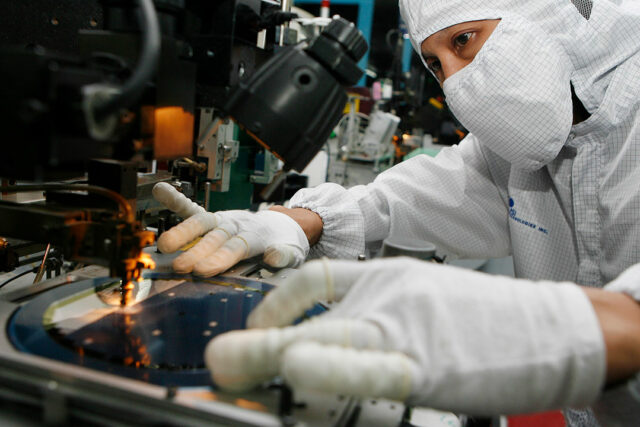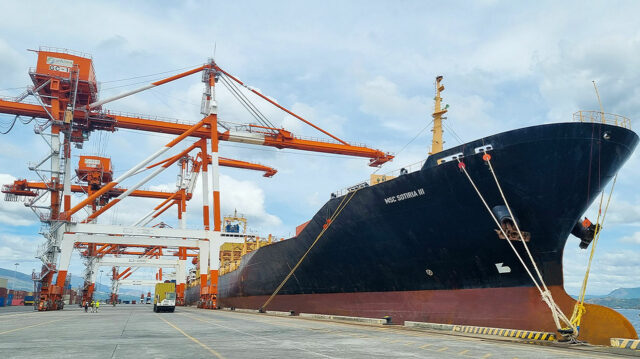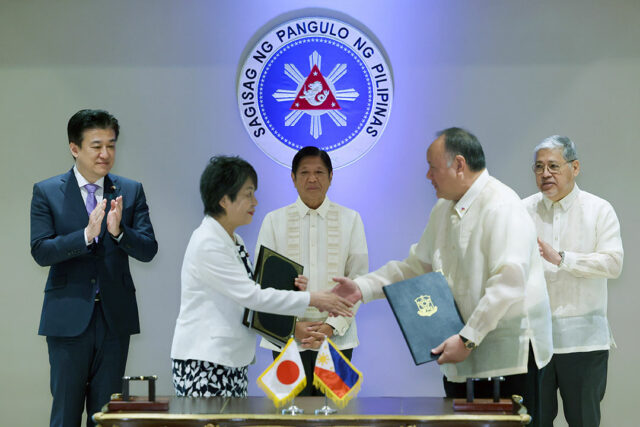By John Victor D. Ordoñez and Kyle Aristophere T. Atienza, Reporters
THE PHILIPPINES and Japan on Monday signed a pact that eases the entry of equipment and troops for combat training, saying they want stability in the region amid growing tensions with China.
Japanese Foreign Minister Yoko Kamikawa, who visited Manila, called the so-called reciprocal access agreement a “landmark achievement.”
“This is another milestone in our shared endeavor to ensure a rules-based international order,” Philippine Defense Secretary Gilberto C. Teodoro, Jr. told reporters after the signing.
The agreement is the first of its kind to be signed by Japan in Asia, and coincides with increased Chinese assertiveness in the South China Sea, where Beijing’s expansive claims conflict with those of several Southeast Asian nations.
Ms. Kamikawa and Mr. Teodoro signed the deal in the presence of Philippine President Ferdinand R. Marcos, Jr. and Japanese Defense Minister Minoru Kihara at the presidential palace in Manila.
Ms. Kamikawa and Mr. Kihara were in Manila for the second 2+2 ministerial meeting with their Philippine counterparts.
“Your presence here increases our confidence,” Mr. Marcos told the Japanese side. “I’m very glad that we have come to this day.”
A United Nations-backed tribunal based in the Hague in 2016 voided China’s expansive claims in the sea for being illegal.
Japan, which last year announced its biggest military build-up since World War II in a step away from its post-war pacifism, does not have any claims to the South China Sea, but has a separate maritime dispute with China in the East China Sea, where they have repeatedly faced off.
It has supported the Philippines’ position in the South China Sea and has expressed serious concern over China’s actions, including recent incidents that resulted in damage to Philippine vessels and injured a Filipino sailor.
“The Philippines and other Southeast Asian Nations are situated in… a key junction of Japan’s sea lanes; advancing defense cooperation and exchanges with the Philippines is important for Japan,” Mr. Kihara said.
The Philippines has a visiting forces agreement with the United States and Australia. Tokyo, which hosts the biggest concentration of US forces abroad, has a similar deal with Australia and Britain, and is negotiating another with France.
The reciprocal access agreement will take effect after being ratified by both countries’ Parliaments.
The pact is not targeted against any country, Ms. Kamikawa told a news briefing in Manila after the 2+2 ministerial meeting.
“The Philippines is a strategic partner that shares values and principles with Japan, and strengthening that relationship is not against any particular country in mind but rather something that is crucial for peace and stability in the region,” she said in Japanese.
Japan is committing to provide the Philippines with more patrol vessels and surveillance radar systems that it can deploy in the South China Sea, she said.
“Japan believes that the issue is directly related to the peace and stability of the Indo-Pacific region, and it opposes any attempt to change the status quo by force,” Mr. Kihara told the same briefing in Japanese.
Philippine Foreign Affairs Secretary Enrique A. Manalo said the military pact with Japan allows the parties to have a framework for cooperation in defense and other related issues. “It could serve as a force for stability in the region, for greater prosperity.”
Joshua Bernard B. Espeña, who teaches foreign policy at the Polytechnic University of the Philippines, said Japan has contributed to the stability of the Indo-Pacific region “throughout the years.”
“So, Manila will gladly accept all the help it would get from it,” he said in a Facebook Messenger chat. He said the pact’s effectiveness would heavily depend on “American contribution to the larger trilateral and regional alliance network.”
‘DEEP WOUNDS’
Don Mclain Gill, who teaches international relations at De La Salle University, said Japan could not replace the US in case American politics turns inward after the November elections “given the strategic limitations Japan still faces in playing a larger role as a defense partner.”
“But Japan remains one of the most important constants in our foreign policy calculations,” he said via Messenger chat. “In a scenario where the US may dial down its support for Manila, our partnership with Japan is likely to remain steadfast and consistent.”
Meanwhile, activist Antonio L. Tinio said the Senate should reject the military pact with Japan because it puts the Philippines in the middle of a potential war in the South China Sea.
The Philippines could be used as a staging ground for foreign military forces if tensions erupt in the waterway, Mr. Tinio, spokesman of civic group P1NAS, said in a statement.
“P1NAS calls on the Filipino people to oppose this dangerous agreement and calls on the Senate to deny its ratification,” he said.
“This agreement must be seen in the context of the ongoing US-led military build-up in the region. The US is pushing its allies, particularly Japan, towards massive militarization to serve as its proxies,” he added.
The military pact is part of the US strategy to contain China and keep its dominance in Southeast Asia, Mr. Tinio said.
“The reciprocal access agreement confirms the US intention to use the Philippines as a springboard for military action… to support its wars,” he added.
“While we stand firm in defending our sovereign rights in the West Philippine Sea, we must not allow this conflict to be used as a pretext for turning our country into a battleground for a US-China war for regional hegemony,” he said, referring to areas of the sea within the country’s exclusive economic zone.
The military pact also “reopens the deep wounds” of war crimes committed by Japan against Filipinos during World War II, he added.
Mr. Tinio said the reciprocal access agreement is not just a simple defense pact.
“It carries profound historical significance that cannot be ignored,” he said. “The Filipino people have not forgotten the atrocities committed during that dark period of our history, including the systematic use of comfort women, the Bataan Death March and countless other war crimes.”
Senate President Francis G. Escudero said they would scrutinize the deal “like other treaties that the Senate is asked to ratify by the Executive.” “Regardless of whether it ‘agitates’ another country, I believe we should pursue it if it is in our national interest and I believe that it is,” he told reporters in a Viber group message — with Kenneth Christiane L. Basilio and Reuters












